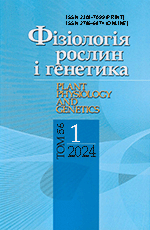Today, food products from the flour of ancient spelt wheat are quite popular in the world and their attractiveness to the consumer is growing, as evidenced by the expansion of acreage under spelt wheat. According to nutritional characteristics, such as the content of vitamins and minerals in the grain, soluble digestible protein, antioxidant activity of the grain, lower immunoreactivity of gluten, the pleasant taste of food products, spelt wheat is dominated by modern high-yielding wheat varieties. The aim of our work was to create spelt wheat with improved nutritional characteristics by transferring to the spelt genome the genes of bread wheat that control the purple color of the grain. As a donor of purple color, the Chornobrova wheat variety with purple grain color was used. As a result of five interrupted backcrosses by pollen of original spelt Schwabencorn and selection of genotypes with purple grain, a unique spelt wheat with dark purple grain was obtained in Ukraine for the first time. The developed variety of spelt wheat with dark purple grain is listed in the State Register of Varieties of Ukraine under the name of Bilberry. Our partner millers society «Dar Mlyn Zakarpattya» Ltd and bakers «Mamyn Khlib™» of company Biligrain have worked out a technology of grinding spelt Bilberry in high-quality whole flour quite suitable for the manufacturing a series of foods with dark brown 100 % natural color and increased nutritional value of grain. Food products from colored grain of spelt wheat first appeared on the food market of Ukraine.
Keywords: Triticum aestivum ssp. spelta L., spelt, increased nutritional value, variety with dark purple grain
Full text and supplemented materials
Free full text: PDFReferences
1. Dubcovsky, J. & Dvorak, J. (2007). Genome plasticity a key factor in the success of polyploidy wheat under domestication. Science, 31 6, pp. 1862-1866. https://doi.org/10.1126/science.1143986
2. Dinu, M., Whittaker, A., Pagliai, G., Benedettelli, S. & Sofi, F. (2018). Ancient wheat species and human health: Biochemical and clinical implications. J. Nutr. Biochem., 52, pp. 1-9. https://doi.org/10.1016/j.jnutbio.2017.09.001
3. Dvorak, J., Deal, K.R., Luo, M.C., You, F.M., von Borstel, K. & Dehghani, H. (2012). The origin of spelt and free threshing hexaploid wheat. J. Heredity, 103, pp. 426-441. https://doi.org/10.1093/jhered/esr152
4. Shewry, P.R. (2018). Do ancient types of wheat have health benefits compared with modern bread wheat? J. Cereal Sci., 79, 4, pp. 469-476. https://doi.org/10.1016/j.jcs.2017.11.010
5. Spisni, E., Imbesi, V., Giovanardi, E., Petrocelli, G., Alvisi, P. & Valerii, M.C. (2019). Different physiological responses elicited by ancient and heritage wheat cultivars compared to modern ones. Nutrients, 11, 2871. https://doi.org/10.3390/nu11122879
6. Salarov, M. & Filip№hev, B. (2020). Spelt vs common wheat: potential advances and benefits. Acta Innovations, 35, pp. 58-65. https://doi.org/10.32933/ActaInnovations.35.4
7. Escarnot, E., Agneessens, R., Wathelet, B. & Paquot, M. (2010). Quantitative and qualitative study of spelt and wheat fibres in varying milling fractions. Food Chem., 122, pp. 857-863. https://doi.org/10.1016/j.foodchem.2010.02.047
8. Bonafaccia, G., Galli, V., Francisci, R., Mair, V., Skrabanja, V. & Kreft, I. (2000). Characteristics of spelt wheat products and nutritional value of spelt wheat-based bread. Food Chem., 68, pp. 437-441. https://doi.org/10.1016/S0308-8146(99)00215-0
9. Abdel-Aal, E-S. M. & Rabalski, I. (2008). Effect of baking on nutritional properties of starch in organic spelt whole grain products. Food Chem., 111, pp. 150-156. https://doi.org/10.1016/j.foodchem.2008.03.050
10. Hammed, A. M. & Simsek, S. (2014). Hulled wheats: a review of nutritional properties and processing methods. Cereal Chem., 91, pp. 97-104. https://doi.org/10.1094/CCHEM-09-13-0179-RW
11. Filip№ev, B., ћimurina, O., Bodroыa-Solarov, M. & Obreht, D. (2013). Comparison of the bread-making performance of spelt varieties grown under organic conditions in the environment of northern Serbia and their responses to dough strengthening improvers. Hemijska Industrija, 67, pp. 443-453. https://doi.org/10.2298/HEMIND120606083F
12. Reiter, E., Werteker, M., Schmidt, L. & Berghofer, E. (2000). Spelt wheats varieties: new aspects and technological properties. In: ¦. Ugar№iє-Hardi, ed., Proceedings of the Second Croatian Congress of Cereal Technologists «Braлno-kruh'99», Opatija, Croatia, Grafika d.o.o., Osijek, pp. 10-15. https://doi.org/10.1201/9781420027228-44
13. Garg, M., Kaur, S., Sharma, F., Kumari, A., Tiwari, V., Sharma, S., Kapoor, P., Sheoran, B., Goyal, A. & Krishania, M. (2022). Rising demand for healthy anthocyanin biofortified colored wheat is a new research trend. Front. Nutr., 9, pp. 1-23. https://doi.org/10.3389/fnut.2022.878221
14. Rybalka, O.I., Morhun, V.V., Morgun, B.V., Polyshchuk, S.S., Chervonis, M.V. & Sokolov, V.M. (2023). New genetic variation related to wheat (Triticum aestivumL.) breeding for quality. Cytol. Genet., 57 (1), pp. 3-16 [in Ukrainian]. https://doi.org/10.3103/S0095452723010103
15. Rybalka, O.I. & Pokoievoi, H.V. (2011). Device for determination of sedimentation SDS-30. Patent of Ukraine № 65644; State register for useful models. 12.12.2011 [in Ukrainian].
16. Rybalka, O.I. (2010). Protocols for electrophoretic analysis of wheat gluten proteins. Sci. Bull. SGI-NCNS, 16, pp. 171-179 [in Ukrainian].
17. Abdel-Aal, E.-S. & Hucl, P. (1999). A rapid method for quantifying total anthocyanins in blue aleurone and purple pericarp wheats. Cereal Chem., 76 (3), pp. 350-354. https://doi.org/10.1094/CCHEM.1999.76.3.350
18. Scientific opinion on the re-evolution of caramel colors (E150a,b,c,d) as food additives. EFSA panel on food additives and nutrient sources added to food (ANS). European Food Safety Authority (EFSA), Parma, Italy. EFSA Journal, 9 (3), 2004, p. 103. https://doi.org/10.2903/j.efsa.2011.2004
